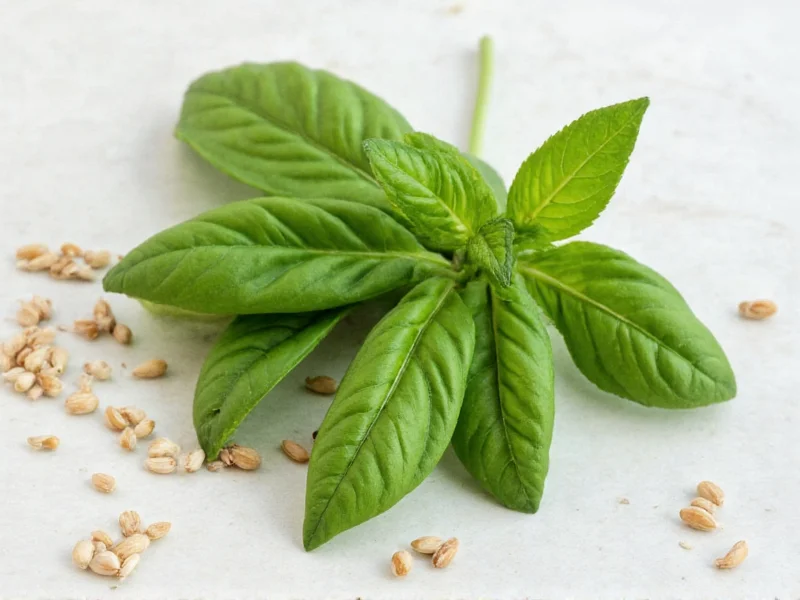Understanding how to properly substitute dried basil for fresh is essential for home cooks facing pantry limitations. While fresh basil offers bright, sweet notes with hints of anise, dried basil provides a more concentrated, earthy flavor profile. The key to successful substitution lies in understanding both the measurement conversion and the culinary implications of this switch.
Why Dried Basil Requires Different Measurements
When herbs dry, they lose approximately 80-90% of their water content. This concentration means dried basil packs significantly more flavor per volume than its fresh counterpart. The drying process also alters the chemical composition, diminishing some volatile oils while intensifying others. This explains why simply using equal amounts won't yield comparable results in your dishes.
Complete Fresh Basil Substitute Dried Conversion Chart
| Recipe Calls For | Fresh Basil Substitute Dried Amount | Best For |
|---|---|---|
| 1 tablespoon fresh basil | 1 teaspoon dried basil | Sauces, soups, stews |
| 1/4 cup fresh basil | 1 tablespoon dried basil | Casseroles, braises |
| 1 cup fresh basil | 1/4 cup dried basil | Large batch cooking |
| 1 large bunch (about 2 oz) | 2 tablespoons dried basil | Tomato-based dishes |
When Substitution Works Best
Dried basil shines in slow-cooked dishes where it has time to rehydrate and release its flavors. Think tomato sauces simmering for hours, hearty soups, or braised meats. The extended cooking time allows dried basil's more subtle notes to emerge. For pesto or caprese salad, however, fresh basil remains irreplaceable - its delicate texture and bright flavor simply can't be replicated with dried.
Consider these factors when making your fresh basil substitute dried decision:
- Cooking duration: Longer cooking = better dried basil integration
- Dish moisture content: Wet dishes help rehydrate dried herbs
- Flavor balance: Dried basil has earthier notes that may require seasoning adjustments
- Basil quality: Older dried basil loses potency (check freshness by aroma)
Expert Tips for Perfect Basil Substitution
Professional chefs recommend these techniques when using dried basil as a fresh basil substitute:
- Toast dried basil in a dry pan for 30 seconds before adding to dishes to enhance flavor release
- Add dried basil early in the cooking process (unlike fresh which goes in at the end)
- Reconstitute dried basil by mixing with 1 teaspoon warm water or olive oil per tablespoon of herb
- Adjust acidity - dried basil benefits from a splash of vinegar or lemon juice to brighten flavors
- Combine with complementary herbs like oregano or thyme to build complexity
Common Substitution Mistakes to Avoid
Many home cooks make these errors when substituting dried for fresh basil:
- Using equal measurements instead of the proper 3:1 ratio
- Adding dried basil at the same stage as fresh (should go in earlier)
- Not adjusting other seasonings to compensate for flavor differences
- Using old, stale dried basil that has lost its essential oils
- Expecting identical flavor rather than a complementary alternative
Remember that dried basil won't provide the same bright, grassy notes as fresh - it creates a different but equally delicious flavor profile when used correctly. The goal isn't perfect replication but thoughtful adaptation to your available ingredients.
Special Considerations for Italian Cuisine
When preparing traditional Italian dishes, understanding fresh basil substitute dried ratios becomes particularly important. Classic tomato sauces like marinara traditionally use fresh basil added at the end, but when substituting dried, add it during the initial sauté of aromatics. For pesto, dried basil won't work well due to texture requirements, but you can create a "winter pesto" using dried basil combined with extra garlic and pine nuts.
Professional Italian chefs often keep both forms in their pantries, using dried basil as the flavor foundation during cooking and finishing with fresh for brightness. This hybrid approach works well when you have limited fresh basil but want to maximize its impact.
Troubleshooting Basil Substitution Issues
If your dish tastes too strong after adding dried basil, try these fixes:
- Add a splash of acid (lemon juice or vinegar) to balance flavors
- Incorporate dairy like cream or cheese to mellow intensity
- Dilute with additional base ingredients (more tomatoes, broth, etc.)
- Add a pinch of sugar to counter bitterness
- Introduce complementary flavors like garlic or red pepper flakes
For dishes lacking basil flavor, create a quick basil oil by steeping additional dried basil in warm olive oil for 10 minutes, then drizzle over your finished dish.











 浙公网安备
33010002000092号
浙公网安备
33010002000092号 浙B2-20120091-4
浙B2-20120091-4